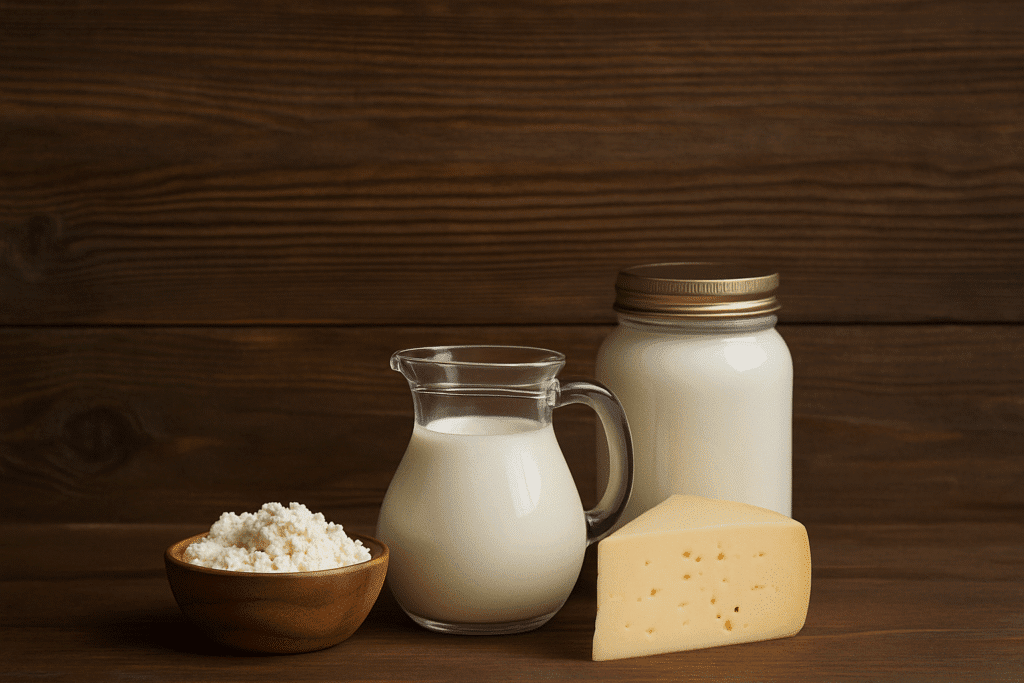Raw milk is making a comeback—and not just with crunchy moms and homesteaders. More people are realizing that this old-school superfood might actually be better than the stuff in plastic jugs at the grocery store.
Why? Because raw dairy is real food. It hasn’t been blasted with heat, stripped of its nutrients, or “fortified” to replace what was lost. It’s packed with the enzymes, bacteria, and vitamins that actually make milk good for you.
Let’s break it down: what raw dairy really is, why it disappeared, and what the latest science is saying now that people are finally asking better questions.
What Is Raw Dairy?
Raw dairy is milk in its natural state—unpasteurized, unhomogenized, and untouched by industrial processing. It comes straight from healthy, grass-fed cows, goats, or sheep.

That means it still contains:
- Digestive enzymes
- Probiotic bacteria
- Immune-boosting compounds
- And all the natural fats that your body actually wants
It’s what milk looked like before we decided to make everything shelf-stable and flavorless. And if you’re eating ancestrally or following a Paleo lifestyle, this is the kind of dairy that actually fits.
Why Did Raw Milk Get Banned in the First Place?
Back in the early 1900s, unsanitary milk practices in overcrowded cities were making people sick. So instead of cleaning up the process, they went for the quick fix: pasteurize everything.
Problem solved, right? Sort of.
Pasteurization kills bacteria—but it also destroys the good stuff:
- Lactase (helps break down lactose)
- Probiotic cultures (hello, gut health)
- Vitamin A in its natural form
- Enzymes that help absorb calcium and other minerals
So yes, pasteurization made milk safer during the industrial revolution—but in doing so, it turned a nutrient-dense, living food into… well, a white liquid with a long shelf life and not much else.
Is Raw Milk Safe?
Here’s the honest answer: It depends on how it’s sourced.
If your raw milk comes from a dirty, industrial farm—that’s a risk. But when it’s from small-scale, healthy, grass-fed cows that are regularly tested? The risk is incredibly low.
And get this:
According to studies from Harvard and the Journal of Food Protection:
- Raw milk is not the pathogen bomb it’s made out to be.
- Kids who drink raw milk have fewer allergies, less asthma, and stronger immune systems.
- Raw milk may actually help build immune tolerance to common environmental triggers.
Compare that to the outbreaks we see regularly from bagged lettuce, deli meats, and even cantaloupe—and suddenly, raw milk doesn’t look so scary.
What You Keep in Raw Milk
Here’s a side-by-side comparison that says it all:
| Nutrient/Compound | Raw Milk | Pasteurized Milk |
|---|---|---|
| Lactase enzyme | Yes (helps digest lactose) | Destroyed by heat |
| Vitamin A (Retinol) | Fully bioavailable | Oxidized, less useful |
| Probiotics | Abundant | Killed |
| Immunoglobulins | Immune support intact | Gone |
| CLA (healthy fat) | Present | Reduced |
| Vitamin B2 | Retained | Significantly lowered |
In short, raw milk works with your body. Pasteurized milk… not so much.
Real-Life Benefits People Report
Switching to raw dairy? These are the changes people rave about:
– No more bloating (even for “lactose intolerant” folks)
– Clearer skin
– Fewer seasonal allergies
– Less sugar cravings
– Way better digestion
– More energy and stronger immunity
It’s like your body knows what to do with real food. Who would’ve thought?
Not All “Raw” Dairy Is Created Equal
If you’re going to try raw dairy, quality is everything. Look for:
- 100% grass-fed
- No antibiotics, no hormones
- Transparent, small farms (not industrial)
- Clean testing practices
Trusted names like Organic Pastures, Miller’s Organic Farm, or your local raw dairy co-op are a great place to start.
Not ready to dive in with milk? Try raw kefir, raw cheese, or raw yogurt first—they’re easier to digest and still give you the benefits.
Leave a Reply